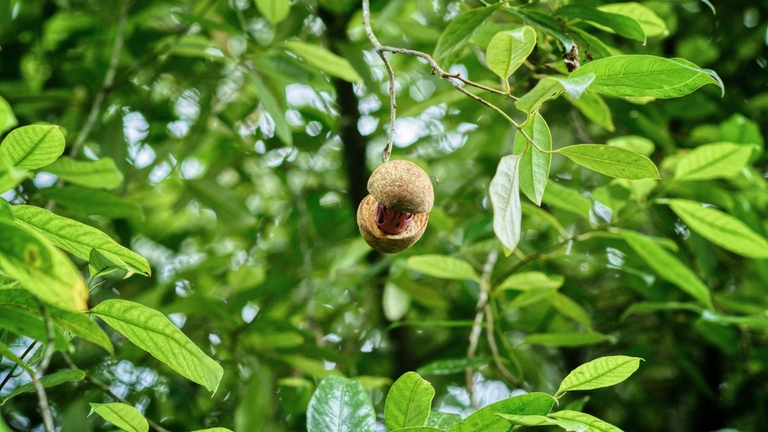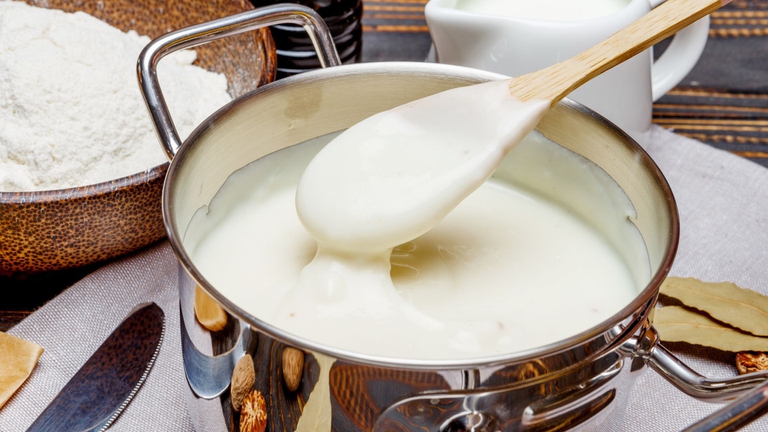https://www.lifegate.it/noce-moscata
- |
- Nutmeg is an Indonesian spice with an intense and characteristic aroma and interesting properties.
- In the right doses it is an excellent ingredient for enhancing dishes.
- Its phytochemical composition presents various peculiarities, both beneficial and harmful.It is therefore important to use it sparingly.
The term nutmeg identifies the spice resulting from Myristica fragrans, a tropical, evergreen plant native to Indonesia.The dried and shelled seeds are available on the market as they are, although there is no shortage of ready-to-use powdered products.Overall, it is an ingredient appreciated for its own sake aroma, but also an interesting source of bioactive components.However, the adverse effects related to excessive intake are not negligible.
Nutritional values and components of nutmeg
The use of nutmeg as seasoning spice involves very small additions, with minimal impacts in terms of nutritional intake.A teaspoon of this spice, equal to approximately 2 g, has a negligible content of macronutrients (0.2 g of proteins, 0.6 g of lipids and 0.5 of carbohydrates), for an energy value of nine kilocalories.Among the micronutrients present in traces, magnesium, manganese and copper stand out, but also thiamine, vitamin B6 and folic acid.

Nutmeg essential oils
The seed contains approximately ten percent of essential oils, composed mostly of terpene hydrocarbons (e.g.:sabinene, limonene), terpene derivatives (e.g.:linalool, geraniol) and phenylpropanes.Among other things, the components myristicin and elemicin belong to the latter class, which are toxic if taken in excessive quantities.Herbal production makes available the nutmeg essential oils, obtained from seeds through distillation.These products are suitable for environmental diffusion, alone or combined with other essences, but also for cosmetic use (in addition to creams, massage lotions or body cleansing products) and for flavoring foods.In any case, it is good practice to rely on expert connoisseurs of essential oils, avoiding risky excesses.

Properties and benefits
Some components of nutmeg, such as beta-caryophyllene and eugenol, boast a strong potential antioxidant, becoming functional against oxidative stress.Other substances, classified as lignans and studied with in vitro experiments, have instead shown aimmuno-modulating action.Some laboratory investigations also attribute to the spice antimicrobial properties, highlighting specific components, such as myristic acid, carvacrol and some lignans.The activity was detected against various bacterial species (e.g.: B.cereus, S.aureus, AND.coli, P.aeruginosa) and fungal (e.g.: Candida albicans);some authors suggest anti-inflammatory properties to the oils obtained from the spice.Eugenol, specifically, has shown suppressive activity on some inflammatory mediators.In vivo observations have highlighted, for nutmeg oils, attenuating effects on pain.The phytochemical composition of this spice revealed cardioprotective properties significant.This property, which is promising in therapeutic terms, is attributed to various substances, such as eugenol and quercetin.

Nutmeg also seems to be functional for the well-being of the intestine, boasting antidiarrheal and carminative properties.Among the best-known properties, that one stands out aphrodisiac.In recent times, this aspect has been explored and documented through in vivo studies.Also noteworthy is the antidiabetic potential, in terms of improving insulin sensitivity and glucose metabolism.There is no shortage of interesting ones anti-tumor potential, highlighted thanks to in vitro experiments.The substances studied in this sense include essential oils, flavonoids and phenolic components.
Adverse effects and contraindications
Due to its content of myristicin and elemicin, nutmeg can result toxic if consumed in high doses, associated with nausea, agitation and even hallucinations.Myristicin, specifically, has structural similarities with a further substance, safrole, classified as a precursor of ecstasy.To date, cases of intoxication remain rare, and the spice is considered safe if consumed in small quantities.Use as a condiment, in any case, requires thrift during pregnancy, breastfeeding and during therapy with psychotropic drugs.The use of essential oils requires careful reading of the instructions provided, as well as desirable professional support.
How much nutmeg to consume
The use of the spice requires very low quantities, less than 2 g per day.A dose of this type is compatible with a good aromatic yield, while it is not usually associated with noteworthy adverse effects.

Uses in the kitchen
Nutmeg is a fragrant spice, with a strong, slightly sweet and woody aroma.Its organoleptic characteristics are exploited to embellish various types of dishes, starting from first courses with bechamel sauce and homemade stuffed pasta.This spice is excellent for flavoring vegetable soups or mashed potatoes, but also for giving an aromatic touch to meat or fish main courses.
The sweetish flavor of this spice can also be adapted, avoiding excesses, to the preparation of jams, biscuits and desserts of various types.
FAQs
-
How toxic is nutmeg?
Taking excess nutmeg can be toxic, and correlate with adverse effects such as nausea, agitation and hallucinations.This is due to the presence, in the seeds, of substances known as myristicin and elemicin. -
What are the benefits of nutmeg?
According to some studies, it boasts antioxidant, immuno-modulatory, anti-inflammatory and antimicrobial properties, but also anti-diarrheal and carminative effects.Furthermore, there would be no lack of anti-diabetic, cardioprotective and anti-tumour potential.Among the best known properties is the aphrodisiac one. -
How much nutmeg can you eat?
To exploit its aroma without incurring potential adverse effects, it is preferable to take less than 2 g per day. -
Who can't eat nutmeg?
Its consumption should be reduced or avoided during pregnancy and breastfeeding, as well as in the context of psychotropic drug therapy. -
What to use nutmeg for?
It is a good aromatic choice for first courses based on béchamel, but it is also an excellent ingredient to enhance meat, fish and vegetable soups.This spice is also suitable for sweet preparations, such as biscuits, jams and creams.
